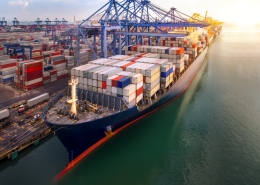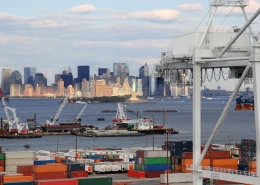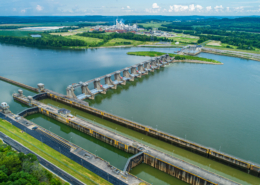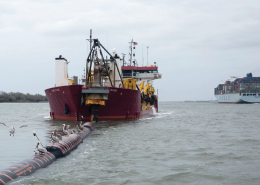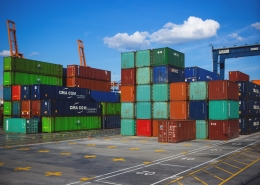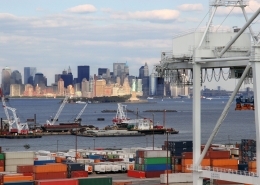On Thursday, March 21st, the House Transportation and Infrastructure Subcommittee on Highways and Transit met for a hearing titled “Rural Transportation Challenges: Stakeholder Perspectives.” The subcommittee called on witnesses to provide insights from industry and local-level stakeholders on issues and challenges for rural transportation.
Witness List
- Mike Koles, Executive Director, Wisconsin Towns Association, on behalf of the National Association of Towns and Townships
- Jeff Greteman, President, Windstar Lines, on behalf of the American Bus Association (ABA)
- Todd Morrow, Executive Director, Island Transit, on behalf of the Community Transportation Association of America (CTAA)
- Scott VanderWal, National Vice President, American Farm Bureau Federation
Context
While only around 19 percent of the US population live in rural areas, they account for over 90 percent of the total land mass of the US. Moreover, 68 percent of the total lane miles are in rural areas. In their opening remarks, the witnesses pointed to rural transportation as an important part of the transportation network. Milk, concrete, toilet paper, and the nation’s forest products are all examples of products that rely on local and rural roads to move onto the larger transportation network and across the country. The farms that comprise the breadbasket of the United States utilize the rural transportation network to get food to and from the markets. Public and private transportation operators in rural areas provide critical access to schools, healthcare, groceries, social services, and connections to larger transit services for millions of people.
Rural transportation in the United States comes with unique challenges. While rural roads account for a sizable portion of the nation’s total lane miles, rural residents may have limited transportation options. Thirty-six percent of rural residents have a choice between air, rail, and bus transportation options. As noted by subcommittee ranking member Eleanor Holmes-Norton (D-DC), public transit and its challenges are present in urban and rural areas. Elderly residents, persons with disabilities and families who cannot afford a car may rely on transit in rural areas to get where they need to go. Capacity concerns, the need for modern transit facilities, congestion (for example, if a rural one-lane road is the one connection to town or larger highway, traffic can back up on that rural road), and poor infrastructure are all just as important for rural communities as they are for urban communities.
The condition of rural infrastructure varies, with thousands of roads and bridges in poor conditions needing improvements. Koles noted that in Wisconsin, 42,000 bridges are structurally deficient, many in rural areas, not including culverts (tunnels that carry drainage pipes or creeks under roads or railways). Across the country’s rural areas, there are around 3,000 closed bridges, forcing drivers to make longer detours. Safety is another concern with rural transportation. While only 19 percent of the total US population live in rural areas, 43 percent of all roadway fatalities occur on rural roads. Pressures from the pandemic, drought, and supply chain issues have put a strain on farmers, and a robust transportation network is crucial to keeping the agricultural sector afloat.
The challenges of rural transportation are many, and ranking member Holmes Norton and full committee ranking member Rick Larsen (D-WA) pointed to the importance of increased investment from the Infrastructure Investment and Jobs Act (IIJA) in strengthening the rural transportation network. Billions of dollars from the Rural Transportation Assistance Program, ROUTES program, and RAISE program have been critical in providing necessary investments in rural infrastructure that will improve mobility, connectivity, and economic development for rural communities. Under the Bridge Formula Program, 15 percent of bridge formula funding is set aside for off-system bridges, or those not part of the interstate highway system, and many of these are in rural areas.
Throughout the hearing, the witnesses and representatives discussed the challenges and opportunities in rural transportation around four themes: federal transportation requirements/priorities, rural transit issues, grant program concerns, and maintaining/improving rural infrastructure.
Federal transportation requirements/priorities
Several representatives voiced concerns and frustrations over various transportation requirements including greenhouse gas performance measures, climate change-focused policies, and shifting transportation priorities towards mass transit or pedestrian/bike infrastructure. In response to chair Rick Crawford’s (R-AR) concern over GHG performance measures, Greteman noted that the measures can influence how states use revenues and fund projects that are possibly unnecessary. VanderWal added that in some rural areas, mass transit, bike and pedestrian infrastructure projects are not relevant. Additional federal requirements for infrastructure projects can complicate the process and hinder progress on other rural needs. Responding to Rep. John Duarte (R-CA), VanderWal urged the committee to keep its priorities in line. Rather than additional federal requirements, he suggested that states should have increased autonomy in deciding how to use funds to serve their needs.
Throughout the hearing, the topic of hours of service emerged. Greteman noted that the uniformity in the Federal Motor Carrier Safety Administration (FMCSA)’s guidelines on hours of service is important. The hours-of-service guidelines set rules for how long operators carrying property or passengers can drive. He expressed concern over having different rules in different states, which could make interstate commerce more complicated. For example, under a system with different hours of service rules, there could be confusion about which set of rules to follow if a bus operator starts a trip in Iowa and ends in Arkansas. VanderWal was supportive of hours-of-service exceptions, stating that for ranchers, having to gather livestock can vary by hours and the exceptions protect ranchers’ ability to sell. The exceptions discussed apply to a driver operating within a 150-mile radius of their work location, not exceeding 14 hours. Responding to Rep. Tracey Mann (R-KS), VanderWal suggested that making the hours-of-service exception permanent would save the trouble of having to push for its renewal every year.
Alongside hours-of-service exceptions, VanderWal also discussed the benefit of weight exceptions, responding to Rep. Dusty Johnson (R-SD). During times of emergency, when farmers want to ship extra produce to farmers in other states, the weight exceptions give flexibility to states and farmers. While this example highlighted the need for flexibility in certain situations, Koles noted that the extra weight on trucks poses a safety risk, as the extra weight places further strain on bridges in rural areas.
Rural Transit Issues
As noted during the opening remarks, transit issues are just as pertinent to rural areas as they are to urban areas. There are various challenges that rural areas face in providing excellent quality transit. Morrow noted that workforce and expanded hours are challenges facing rural transit agencies, notably Island Transit, which serves Island County, WA. Morrow noted that essential workers work later hours, but the transit agency does not currently operate during later hours. If the goal is to support essential workers, expanding operating hours is crucial, but can be a challenge for rural agencies due to operating costs and other factors.
Several representatives inquired about strategies and best practices that can address challenges facing rural transit. Increasing or adding services, extending hours, and investing in bus facilities and vehicles were among the different strategies discussed throughout the hearing. Morrow noted that on-demand transit is a cost-effective method to improve transit in rural areas. Responding to Rep. Valerie Foushee’s (D-NC) question on how to mitigate increased traffic on rural roads for those who commute longer distances, Morrow noted that more investment in transit will take cars off roads. Also, having more buses instead increases the rural roads’ capacity without adding additional lanes.
Rep. Henry Johnson (D-GA) discussed proposed legislation that would create a grant program to support operational costs of transit for underserved and unserved urban and rural communities. The witnesses noted that an investment in operational costs would be helpful. Morrow added that it is important to have continued operational funding. The worst-case scenario is to introduce a service and be forced to cut that service because the money ran out.
Grant Program Issues
Concerns over the grant program system and grant application process emerged several times during the hearing. Koles noted that the process to apply for grants is complicated, and he voiced concern over getting the money to where it is needed. Koles noted several times that getting money down to the local roads is critical. He stated that formula grants are better than discretionary grants. Discretionary grants are grants awarded to eligible applicants in a competitive selection process. USDOT operating administrations (FRA, FTA, FHWA, FMCSA, etc.) go through applications and award grants to applicants based on their discretion (the discretion of the operating administration). Formula grants are non-discretionary, meaning the funds go to every recipient in a group. There are a set of conditions in a formula grant and every recipient who meets those conditions receives funding (discretionary funding does not go to every applicant but formula funding goes to everyone who falls under the conditions of the formula grant, making it non-discretionary).
Rural communities may not have the resources or expertise to apply for grant program funding. Many rural towns have limited city staff, which creates significant difficulty in dedicating the time required for grant submission processes. Additionally, small rural towns must compete for grant program funding with larger towns. For a project to be eligible for the Rural Transportation Assistance Program, the project must classify as “rural,” which is defined as either in an urban area with a population less than 200,000, or outside an urban area. Rep. Derrick Van Orden (R-WI) and Pete Stauber (R-MN) noted that lowering the number from 200,000 would level the playing field for smaller rural towns in competing for grant funding. Koles and Morrow offered their ideas to address the grant writing issue. Providing rural communities with funding to hire grant writers can reduce the burden from rural transportation departments with more capacity. Additionally, providing guidance on when grant opportunities emerge and organizing workshops to train people on the grant-writing process would benefit rural communities.
Maintaining Good Rural Infrastructure
Given the importance of rural transportation, there was discussion about ensuring that rural infrastructure is maintained and kept to a standard of good repair. Rep. Greg Stanton (D-AZ) highlighted the need to keep rural transportation infrastructure in good condition for rural and tribal communities. When rural roads, sometimes unpaved roadways, are affected by inclement weather, the impacts can be more severe, preventing people from getting where they need to go. Koles noted that there are cost-effective improvements to rural roads, including highway dividers and rumble strips. Again, Koles emphasized the importance of getting funding down to local level, to where it is needed. Rep. Val Hoyle (D-OR) noted that lack of good rural infrastructure makes it hard for rural transit agencies to compete with urban transit agencies in attracting employees.


